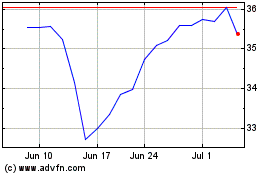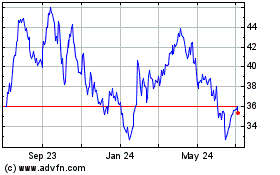Natural Gas Supplies Still Abundant - Analyst Blog
February 06 2012 - 10:15AM
Zacks
The U.S. Energy Department's weekly
inventory release showed a larger-than-expected drop in natural gas
supplies in the midst of a brief, cold snap in the Pacific
Northwest. However, this is largely seen as a one-off shot, with
warmer-than-normal temperatures across most of the country
restricting the commodity’s requirement for power burn. In fact,
gas stocks – currently 25.4% above the 5-year average and 24.6%
higher than the same period last year – are at their highest level
for this time of the year, reflecting low demand amid robust
onshore output.
The Weekly Natural Gas Storage
Report – brought out by the Energy Information Administration (EIA)
every Thursday since 2002 – includes updates on natural gas market
prices, the latest storage level estimates, recent weather data and
other market activities or events.
The report provides an overview of
the level of reserves and their movements, thereby helping
investors understand the demand/supply dynamics of natural gas.
It is an indicator of current gas
prices and volatility that affect businesses of natural
gas-weighted companies and related support plays like
Anadarko Petroleum Corp. (APC),
Chesapeake Energy (CHK),
EnCana Corp. (ECA), Devon
Energy Corp. (DVN), Nabors
Industries (NBR), Patterson-UTI
Energy (PTEN), Helmerich &
Payne (HP) and Halliburton Co.
(HAL).
Stockpiles held in underground
storage in the lower 48 states fell by 132 billion cubic feet (Bcf)
for the week ended January 27, 2012, above the guidance range (of
123–127 Bcf draw) as per the analysts surveyed by Platts, the
energy information arm of McGraw-Hill Companies Inc
(MHP).
The decrease – the tenth
consecutive withdrawal of the 2011-2012 winter heating season after
stocks hit an all-time high in mid-November – is well below last
year’s draw of 187 Bcf and the 5-year (2007–2011) average drawdown
of 186 Bcf for the reported week. The current storage level – at
2.966 trillion cubic feet (Tcf) – is up 586 Bcf (24.6%) from last
year and 601 Bcf (25.4%) over the five-year average.
A supply glut has pressured natural
gas prices during the past year or so, as production from dense
rock formations (shale) – through novel techniques of horizontal
drilling and hydraulic fracturing – remain robust, thereby
overwhelming demand. As a matter of fact, natural gas prices have
dropped approximately 50% from 2011 peak of about $5.00 per million
Btu (MMBtu) in June to the current level of around $2.50 (referring
to spot prices at the Henry Hub, the benchmark supply point in
Louisiana).
To make matters worse, mild winter
weather across most of the country has curbed natural gas demand
for heating, indicating a grossly oversupplied market that
continues to pressure commodity prices in the backdrop of sustained
strong production.
ANADARKO PETROL (APC): Free Stock Analysis Report
CHESAPEAKE ENGY (CHK): Free Stock Analysis Report
DEVON ENERGY (DVN): Free Stock Analysis Report
ENCANA CORP (ECA): Free Stock Analysis Report
HALLIBURTON CO (HAL): Free Stock Analysis Report
HELMERICH&PAYNE (HP): Free Stock Analysis Report
MCGRAW-HILL COS (MHP): Free Stock Analysis Report
NABORS IND (NBR): Free Stock Analysis Report
PATTERSON-UTI (PTEN): Free Stock Analysis Report
To read this article on Zacks.com click here.
Zacks Investment Research
Helmerich and Payne (NYSE:HP)
Historical Stock Chart
From Apr 2024 to May 2024

Helmerich and Payne (NYSE:HP)
Historical Stock Chart
From May 2023 to May 2024
